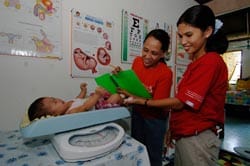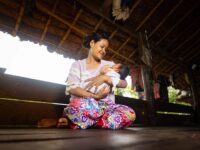Being a mother takes courage. Being an expectant mother in desperate poverty takes courage and so much more.
Each year more than 500,000 mothers die in childbirth or from pregnancy complications, most of which are preventable. The babies who survive while their mothers die are much more likely to die in their first year of life.
Facts About Child Survival
- About half of all deaths of children younger than 5 are caused by malnutrition.
- Brain development starts five weeks after conception and is most affected by nutrition between mid-gestation and 2 years of age.
- Four million babies die each year in their first month of life. Half of these babies die in the first 24 hours of life.
Our Child Survival Program strives to reduce the troubling mortality statistics.
Child Survival Program Mission
The mission of our Child Survival Program is:
To rescue infants at risk of dying by providing nutritional information to the pregnant mothers, assisting in the birth, and providing prenatal and postnatal health care and nutrition assistance.
Since infant mortality is extremely high in the developing world, our first priority in promoting effective child development is to ensure that children survive the early years when they are most vulnerable to disease and malnutrition. That means educating the mother or primary caregiver, before and after her child is born, about providing critical care during the earliest years.
Our Child Survival Program provides:

- prenatal care and infant survival training for mothers and caregivers, as well as spiritual guidance and education, such as literacy and income-generation training
- ongoing health screenings and immunizations for the children
- child development training for mother’s of children under 4
We have adopted a strategy (GOBI-FFF), developed by the World Health Organization and UNICEF, to ensure that we address all the issues affecting immediate child survival and children through the first years of life.
GOBI-FFF is an acronym for:
- growth monitoring
- oral rehydration therapy
- breast-feeding
- immunization
- female literacy
- food supplements
- family spacing
Child Survival vs. Child Mortality
The underlying and structural causes of child mortality include:
- poorly resourced, unresponsive and culturally inappropriate health and nutrition services
- lack of food
- inadequate feeding practices
- lack of hygiene and safe water or sanitation
- female illiteracy
- early pregnancy
Basic health interventions such as breast-feeding, immunization, insecticide-treated mosquito nets and vitamin A supplements are highly successful in lowering a child’s risk of death. And according to the World Bank, immunization and vitamin A supplementation are two of the most cost-effective health interventions available today.
Child Survival Program: How It Works
Our local church partners carry out this ministry and contextualize the program to each situation individually and culturally. The church provides the critical interventions such as nutritious food and medical assistance.
Ultimately, success is based on building open and trusting relationships with the mothers and caregivers, so our church partners invite the mothers and caregivers to get involved in a loving, supportive community. The mothers and caregivers learn how to create a safe home environment and provide the essential developmental opportunities needed to raise happy, healthy children with bright futures.
The families also receive spiritual discipling so they can develop a dynamic lifelong relationship with Christ. Children are stronger, caregivers are more confident, and families and communities benefit from their newly discovered physical, emotional and spiritual strength.
The Child Survival Program is a one-to-one home-based program in which Survival Specialists from the church visit homes and educate mothers in the child’s own environment. There, the actual needs of the baby, mother, family and community will be known, seen and met accordingly.
The program is primarily home-based so we can address the immediate needs of the baby and mother.
When you get into a community and find that most children are malnourished, the best way to get to the root cause of this problem is to visit families in the community.
During the visits, we see and learn what the children are fed and why. We observe the cultural reasons for certain practices, and come up with an action plan from a knowledgeable perspective.
In home visits, mothers learn about parenting practices, including hygiene and nutrition, using locally available foods. Only during home visits can we assess whether what we have been teaching has been put into practice.
Home visits create one-to-one relationships where mothers can open up and share their innermost fears, problems and needs.
Support a Child Survival Program
Sources:
- The State of the World’s Children 2009: Maternal and Newborn Health – UNICEF
- Better Brains for Babies – University of Georgia
- Zero to Three – National Center for Infants, Toddlers and Families







5 Comments |Add a comment
so cute how David falls asleep
I love the CSP, I think it’s a wonderful idea. We need to reach these kids from the moment they are born, so they will have every chance of reaching their full potential.
i’ve visited quite a few Compassion Int’l countries, and the Child Survival Program is always what impresses me the most. I remember in particular walking through a slum in Kampala, Uganda with a local church volunteer in charge of visiting the mothers in that community. She works tirelessly visiting these mothers and making sure their babies survive and thrive well beyond their 5th birthday. I greatly respect and applaud CI’s (and their donors) commitment to CSP. I hope you can continue to expand this program.
Those are staggering facts. When I’m presenting Compassion to a church or church group, I love to cover the three core programs and the Complementary Interventions. Depending on the group, I love delving into the Child Survival Program, because it’s so unique, in its focus not only on child survival, but on the mother/child unit, the training the mom (or other caregiver) receives, the connection to the church and the hope in Jesus Christ that these mothers hear about. All of the core programs are outstanding, but without CSP, too many young’uns were dying before they were old enough to be registered, and their mothers might never have received the hope and the life that can be theirs!
I was fairly amazed to see the program in action in the Philippines and how it worked etc.